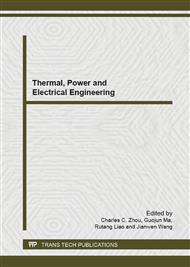p.348
p.352
p.357
p.362
p.368
p.376
p.382
p.387
p.392
The Model of a Free Piston System Based Organic Rankine Cycle and the Analysis of Sensitive Factors
Abstract:
For recycling complementary energy efficiently, WMs latent heat of vaporization is made full use of in a free piston based organic rankine cycle exhaust gas energy recovery (ORC-FP) system. In this paper, the model of ORC-FP system has been established by the software GT-suite 7.0. Three sensitive factors (WMs gas ratio, piston damping coefficient and power WMs pressure) will be discussed by simulation results. The conclusions are shown as follows: Firstly, when WM state is 450K, 1.1MPa (Power WM) and 320K, 1.1MPa (Cooling WM) at inlet, the systems single cycle efficiency is highest about 69.21%, and the lowest is about 42.32%. Certain fluctuation of single cycle (SC) efficiency exists between two adjacent cycle, and the highest difference can reach 26.89%. Secondly, the systems total cycle (TC) efficiency decreases along with the increasing of damping coefficient (piston load). At the minimum piston damping coefficient (about 7500 N-s/m), the systems highest total cycle efficiency is 46.53%, and at the maximum (about 8750 N - s/m), the lowest total cycle efficiency is 35.66%. Thirdly, when damping coefficient is 7500 N-s/m, the higher pressure of WM is, the higher the systems total cycle efficiency is. In the pressure of 1.1MPa, the system reaches the highest efficiency which is about 46.53%, and in the pressure of 0.9 MPa reaches the lowest which is about 26.74%.
Info:
Periodical:
Pages:
368-375
Citation:
Online since:
August 2013
Authors:
Keywords:
Price:
Сopyright:
© 2013 Trans Tech Publications Ltd. All Rights Reserved
Share:
Citation:


